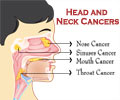World Head and Neck Cancer Day sheds light on the increasing burden of head and neck cancers in India, that accounts for 57.5% of the cases in Asia.
- Despite being the sixth most frequent cancer in the world, India accounts for 57.5% of all head and neck cancer cases
- This is largely due to changing lifestyles, increased lifespan, and addiction to alcohol and cigarettes
- A majority of patients in India present at an advanced stage and this causes them to undergo radical treatment that may result in some disfigurement
Head and neck cancers rising in India: How lifestyle changes can reduce the risk
Go to source).
Anatomical complexity of this region has contributed to the heterogeneity and varied biology of these cancers. Post-treatment, affected individuals experience disabilities of varying magnitudes, especially with speech and swallowing.
Most of these cancers can be prevented, and many of them are treatable if detected early.
Causes of Head and Neck Cancer
Identifying the causative factors of these cancers can reduce their burden dramatically.A patient’s chance of getting cancerous tumors is almost 500–700 times higher in individuals with inadequate immunity and poor ability to metabolize carcinogens.
Consumption of alcohol, areca nut (pan masala), and tobacco (smoked or chewable versions) are major causatives leading to cancer. The risk of head and neck cancer is 35 times higher in heavy drinkers and smokers.
Dietary deficiencies in vitamins A, C, E, iron, selenium, and zinc are further contributing factors. Salty and processed foods are also recognized as contributing factors. Other factors include exposure to air pollutants, too much sun, and certain viruses including HPV, EBV, Herpes, and HIV.
These tumors are also influenced by genetic alterations that have also been linked to them. Those with a first-degree family history of head and neck cancer are at an increased risk of 3.5–3.8%.
Delay Prevails in Diagnoses of Cancer
The reasons for the delay are explained by fear of the illness, misinformation, poor availability of medical care, and financial limitations.The anatomical place where these cancers grow has a significant impact on how they typically manifest. Symptoms include non-healing ulcers, irregular development, vocal changes, and swallowing difficulties. Even though these areas can be inspected visually, two-thirds of patients arrive relatively late in the course of the illness.
The Influence of Socio-Economic Factors in Cancer
The distribution of cancers of the head and neck sub-sites has been found to have a distinct gradient between economically developed countries and less developed ones. Developing countries like India spend less than $10 per person, compared to high-income countries, which typically spend more than $100 per person.More cases are observed in poorer countries due to poor dental hygiene, oral illnesses, and their consequences. On the other hand, developed countries have more cases of smoking-related voice box cancer.
Major setbacks in the lives of cancer survivors still include facial deformity, difficulty understanding speech, chronic pain, dietary restrictions, low self-esteem, a lack of initiative in socializing and competing with peers, and restrictions on job opportunities and professional advancement at work.
Therefore, while these patients continue to struggle with the adverse effects of their medication, mental, physical, and financial support becomes a crucial component in their lives.
It is crucial to rationalize our thinking to simplify and lower the cost of cancer therapy given the rising incidence of the disease and the inadequate infrastructure for providing high-quality cancer care.
Regardless of this, these patients’ chances of surviving have not increased over the past ten years. Patients’ late presentations are the main reason for this. After receiving first-line therapy, 40% of these individuals with localized advanced disease relapse.
Future of Cancer Therapy
Minimally invasive surgeries, organ preservation techniques, and advances in radiotherapy and medical oncology have added value to the treatment of these cancers. The morbidity and mortality has been reduced substantially.Understanding the molecular and genetic makeup of this disease will be crucial for developing effective treatments in the years to come. The discovery of head and neck cancer-specific genes through gene-level research may also aid in early disease detection and prompt, effective treatment.
Targeted therapies and immunotherapeutic medications have recently improved the success rates by delivering medication with precision. With a fresh generation of medications, toxicities and side effects have been somewhat reduced.
We must all cooperate to defeat this cancer. There needs to be more awareness. The current situation demands improving treatment facilities with the addition of palliative care. In the case of terminally ill patients, health education for first-line prevention, early identification through screening programs, and screening facilities.
To combat this humongous challenge of Head and Neck Cancer, the government, health insurance companies, NGOs, medical professionals, and hospitals must work together.
Reference:
- Head and neck cancers rising in India: How lifestyle changes can reduce the risk - (https://www.indiatoday.in/health/story/head-and-neck-cancers-rising-in-india-how-lifestyle-changes-can-reduce-the-risk-2412431-2023-07-27)
Source-Medindia
















